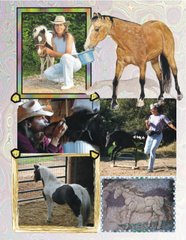Clicker Training has profoundly helped my ability to communicate with the horses and is really working miracles with the old "Buckman." To explain these changes I need to discuss a couple of basic training modes. A standard horse riding technique is to a horse to move away from pressure. For example, if I ask a horse to move sideways from pressure applied by my leg, the best way I can let the horse know he’s on the right track is to release the pressure quickly. So the horse thinks, “Mmm, this is a little uncomfortable, I’ll move over.” Once I feel the horse cooperate I take off the pressure and that signal becomes my way of saying to the horse “Gee, thanks for cooperating, I’ll let you have your comfort back.”
With Clicker Training, the moment the horse cooperates I add a sound (a clicking noise) and follow it up with a treat. It seems simple, but the changes are profound. It’s as if the horse thinks “Hey, you mean I get something I like for doing this?” “Maybe I’ll try harder next time.” I like to think this gives a chance for the horse to work for his own paycheck, and since I really don’t like working for free myself, the whole idea makes sense.
Once my horses understood the possibilities of earning a reward for their behavior, our connection, and
their interest soared. The result is that I have horses that try to “communicate” their interests to me. They’re “eager” for training sessions and they try very hard to “get the right answers.” When I watch them I get this image of Hermoine Granger from the Harry Potter series. She is the young girl who raises her hand with intense enthusiasm because she knows the answer and wants to be called upon.
Horses will even go through a phase where they offer to do behaviors you didn't asked for. They quickly become “empowered” and realize their behavior will get the human to “pay up.” At this point they also realize the human is paying attention and suddenly training looks like a two-way street.
When I added Clicker Training, my horse’s efforts to communicate extended far beyond training sessions, so much so that I started experiencing what I playfully call UPO’s or Unidentified Psychic Occurrences. The following journal entry’s show the progression of some of these UPOs. When reading this, keep in mind, Buck is a deaf horse and his "clicker" is 3 taps on the shoulder.
7/03
UPO
After introducing Buck to the idea of positive reinforcement, he has started to try to communicate with us. A good example is how he acts when he’s being taken to the arena. He has started to make it VERY clear that he’s not interested in hauling the beginning riders around. Basically he stops at the crest of the hill leading down to the arena and plants his feet. Now Buck is trained enough in the old school of horsemanship, that he knows he has to move on, but I swear he stands there long enough to make the statement “Hey, this wasn’t what I had in mind for my day.”
I have to laugh at the old fart, and I love the fact that he’s letting me know how he feels. I’ll try to come up with a way to make the arena a better place to be.
7/05
UPO
I think I’m seeing a real pattern with our lesson horses. We get the kids on the horses and start them at a nice slow pace. We walk right along side working as quickly as possible to get the kids to loosen up and quit squeezing their legs for balance. It’s a real hoot, but I'm seeing that Buck can only tolerate about 3 laps around the arena before he walks straight over to me as if to say “Hey, make this kid lighten up with the reins,” or “Do something about his balance.” If I can get a kid more relaxed and less heavy handed then Buck will stay on the arena fence the whole session. I’m so convinced he’s trying his best to communicate.
This isn’t just happening with Buck. The other horses are beginning to act this way as well. I really think they have expanded their awareness of how to get what they want, and they don’t want to be pinched and yanked around. For us as teachers it presents the challenge of quickly getting the kids to a level of proficiency. The wonder of it is that once we relieve then tension, the horses are willing to go back to work, so I don’t see this as negative behavior on the horse’s part. We’ll see!
7/06
UPO
I’ve added a new dimension for the students riding Buck in this camp. They all wear the treat bag and when Buck cooperates or “listens to them” they tap him 3 times on the shoulder and give him a treat. I’m convinced we’re on our way to making him happier in his job.
7/07
UPO
Danny has really opened up the lines of communication with Buck. Now when they go riding he watches Buck carefully. When they pass a juicy looking clump of grass Buck sort of gestures with his head and Danny makes a mental note of the location. Then, when Buck is moving with cooperation and ease, Danny taps him 3 times and takes him back to the clump of grass. Buck seems to be grasping this concept totally and Danny is getting some wonderful responses.
7/13
UPO
Buck instigated another UPO today. His ability to communicate astounds me every time. Today's incident happened during the morning feeding session. The horses and I have an established ritual. First I feed BW and Nikki and then carry a flake of hay to a spot near Nikki’s pen where Buck can eat but see the other horses.
Today, after dropping off Buck’s hay I went to his corral to let him out. Normally he’s eager to go, giving me just enough time to get his fly mask on and the gate opened before he starts to show a bit of impatience. As it happened today he wouldn't come out of his pen and in fact, once I had gotten done stroking his forehead “hello,” he turned and walked away from me and headed over to his water tub.
I could have just turned around and walked back towards the barn figuring he’d come out and get breakfast when he was ready, but his actions were so different from normal I had to go see what he was up to; he just kept standing there like he wanted me to see something. So I went over and looked into the water tub thinking he might need more fresh water, but instead, in the water was a drowned rat....
It was like Buck was saying "Hey, you, something’s wrong, you need to get this thing out of here!"
By now I should expect this kind of thing from the B-Man, but it still fills me with wonder, feelings of amazement, and that rush of conviction that if we just allow it to happen, we can have extraordinary connections with our horses.
7/18
UPO
Danny had a UPO today. He went to do the evening feed (this ritual is also well established). I put out the horses evening hay and grain during the late afternoon which makes it much easier to feed when it's dark. When Danny arrives, he walks Buck up to his pen and lets him in. By then Nikki is standing by Buck’s pen waiting to escort Danny down to the gate of her pen. Of course that leaves Buckwheat, who, by then, is practically like a dog that takes his leash to his master. Danny doesn’t even use a halter; he just takes Buckwheat by the chin and leads him out through the pasture gate to his pen on the other side of the barn. It’s all very civilized.
Danny said he had all horses put away when he heard Buck calling out again and again with a “frantic whinny.” It was already dark, but Danny figured something was up and went to investigate. He walked into Buck’s pen and at first glance everything seemed to be OK, but as he shined the flashlight into Buck's feed bin he noticed that the grain was missing. Of course Danny went back and brought him some more grain. Danny and I were very impressed that Buck had made such an effort to communicate his problem.
As an interesting footnote to this story, I was very puzzled as to why Buck’s grain was missing until the next day when I went into his pen late in the day. I saw a least a half of dozen crows searching through Buck's dinner. Buck's grain had obviously been discovered by these clever birds.
Now I know lots of horse owners can relate these kinds of stories, but I still find them wonderful. I think it’s such a gift when a human and an animal can create a way to communicate. I think it’s such a gift when a horse with a background like Buck’s, makes the connection that HERE are some human’s who WANT to understand him.





















